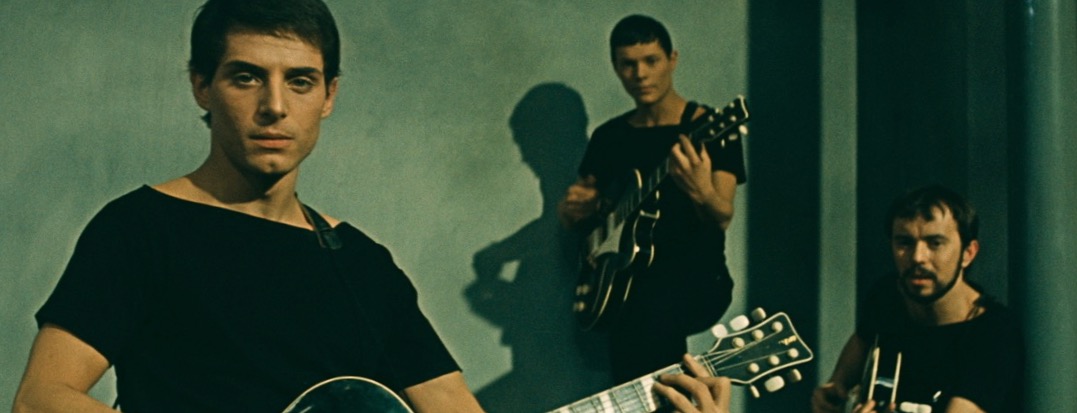
7 December – 21 December
The movie musical, while intermittently revived in the mainstream affections, has long been associated with the golden age of Hollywood between the 1930s and the 1960s. This season demonstrates that the musical has also flourished away from this perceived American “centre” – while still existing in dialogue with it – throughout the subsequent decades. Queer spectatorship has long been associated with the genre, yet remarkably few musicals are marked by an explicit queerness. Exploring a still rich and varied corpus, this season opens with two gender-nonconforming rock musicals which feature a divided Berlin and the collisions of Americans and Germans in their narrative engine rooms: John Cameron Mitchell’s Hedwig and the Angry Inch and one of its key inspirations, Rosa von Praunheim’s City of Lost Souls. The following week pairs Agnieszka Smoczyńska’s extraordinary Polish mermaid horror musical debut The Lure with a recent Japanese rediscovery, Makoto Tezuka’s unhinged The Legend of the Stardust Brothers, both steeped in 1980s aesthetics and concerning musical acts on the make. The final week of the season highlights how the musical was embraced in the Eastern Bloc at the very height of the Cold War, with critique of Western and communist ideologies embedded into both Ladislav Rychman’s The Hop Pickers, from mid-’60s Czechoslovakia, and Gyula Gazdag’s Hungarian Singing on the Treadmill, appearing ten years later. These films round out a season of musicals every bit as energetic as, but more ideologically complex than, their “La La Land” forebears.

7:00pm HEDWIG AND THE ANGRY INCH
John Cameron Mitchell (2001) 92 mins – MA15+
Screenwriter and director Mitchell gives an unforgettable performance as the titular genderqueer, glam-punk East German singer-songwriter transplanted to the US whose protégé, Tommy Gnosis (Michael Pitt), steals her songs and achieves the fame that eludes her. Adapting Mitchell and composer-lyricist Stephen Trask’s own late ’90s hit off- Broadway show, and informed by Plato’s Symposium and The Gospel of Thomas, this dynamic, often hilarious, regularly raucous yet very moving cult-classic queer rock musical features a slew of superb songs as well as animated sequences. It won the Audience Award at Sundance in 2001, where Mitchell also won Best Director.
CTEQ ANNOTATION
To walk away, you gotta leave something behind, or a long story short: Hedwig and the Angry Inch (2001)
by Cerise Howard
8:50pm CITY OF LOST SOULS
Rosa von Praunheim (1983) 94 mins – Unclassified 15+
This riotous and massively ahead-of-its-time intersectional queer-punk musical has gone on to greatly influence transgender politics. Centred around a squalid Berlin burger joint and the ragtag group of multiracial Americans, of a range of gender identities and sexual persuasions, who work there, prodigious activist-filmmaker von Praunheim’s underground classic is equal parts Paul Morrissey-Andy Warhol, John Waters and The Rocky Horror Picture Show, with lashings of satirical Cold War intrigue, searing political commentary, and regular demolitions of the fourth wall. Punk rock icon Jayne County – in a gloriously unrestrained performance – and legendary drag performer Angie Stardust lead the cast, many playing themselves.
CTEQ ANNOTATION
Othering Heights: The Queerest of the Queer in Rosa von Praunheim’s City of Lost Souls (1983)
by Cerise Howard

7:00pm THE LURE
Agnieszka Smoczyńska (2015) 92 mins – Unclassified 15+
Marta Mazurek and Michalina Olszańska play flesh-eating mermaid sisters Silver and Golden. Singing sensations in a seedy nightclub in 1980s Poland, they are subject to differing temptations of the flesh when mixing undetected with humankind, with existential implications for one and all. One of the most audacious feature debuts of recent years, Smoczyńska’s “Daughters of Dancing” (when translated literally from the Polish) is a lurid and dank coming-of-age, synth-pop song-and-dance spectacular drawing on Hans Christian Andersen’s The Little Mermaid and steeping it in strong feminist undercurrents with horror flourishes.
CTEQ ANNOTATION
The Lure (Agnieszka Smoczyńska, 2015)
by Faith Everard
8:45pm THE LEGEND OF THE STARDUST BROTHERS
Makoto Tezuka (1985) 100 mins – Unclassified 15+
Directed by the son of “the Father of Manga”, Astro Boy creator Osamu Tezuka, shot on Super 16mm and bizarrely adapting a soundtrack album written by TV personality Haruo Chikada for a non-existent film, this only recently rediscovered rise-and-fall New Wave musical, with its unflagging cartoonish freneticism, can lay claim to marking “the greatest ‘becoming an overnight sensation’ montage in musical history” (David Ehrlich). Drawing inspiration from Brian De Palma’s Phantom of the Paradise, it features cameos galore from Japanese musicians, manga artists, filmmakers and more, along with an animated sequence by Yōsuke Takahashi.

7:00pm THE HOP PICKERS
Ladislav Rychman (1964) 88 mins – Unclassified 15+
Rychman expanded upon his experience making proto-video clips when bringing to the big screen the first great Czechoslovak musical, a Romeo and Juliet-like tale of teen love often dubbed “East Side Story”. Framed by a trio of guitarists acting as a Greek chorus, this sly satire of the socialist-realist “tractor musical” dramatises the conflict between collective and individualistic principles and foregrounds the interests of youth no less than the films of the contemporaneously emerging New Wave. The film’s terrific songs are sung by domestic pop stars working in the American idiom including Karel Gott, “The Golden Voice of Prague”.
Digital restoration courtesy of the National Film Archive in Prague.
8:45pm SINGING ON THE TREADMILL
Gyula Gazdag (1974) 76 mins – Unclassified 15+
This lively parody, both kitsch and caustic, takes aim at the paternalistic rule of János Kádár as two zany librettists attempt to cast their new operetta. Against the drab background of communist regulation, the intermittent hues of bubble gum pink lighting and social resistance, Gazdag creates a work of surrealist cinematic dissent. Praised as one of the most original of Hungarian filmmakers, the iconoclast Gazdag was a visible target, leading to many of his films, including this one, being initially banned in his home country.
Digital restoration courtesy of the Hungarian National Film Institute.